IRVINE, Calif. November, 2012 At Qzina’s Bean To Bar Experience in 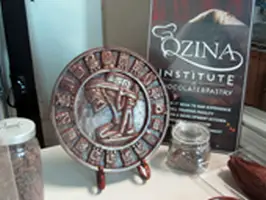
Irvine, California, chocoholics can observe at close range and small scale, beans transformed into divinely delicious chocolate bars.
“Cocoa beans were used as currency by the ancient Mayans. A rabbit cost 10 beans and a prostitute 100,” says Francois Mellet, Qzina corporate pastry chef.
The ancient Olmecs, Mayans and Aztecs cultivated the trees, which probably originated in South America’s tropical rainforests, and spread north to Mexico where it was referred to as “food of the gods.” It was the basis for a thick, unsweetened drink seasoned with spices and reserved for royalty, although priests, decorated soldiers and some merchants enjoyed the beverage on special occasions.
When the Spanish brought the cacoa home, sugar and cinnamon were added to make an expensive 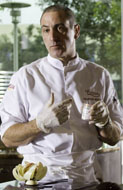 delicious drink that grew into a fad loved by European aristocracy.
delicious drink that grew into a fad loved by European aristocracy.
Mellet (see photo) leads the Bean to Bar experience at the Qzina Institute in Irvine, a new facility designed as a showroom, training center and R & D facility. Qzina sells chocolate, dessert and pastry ingredients as well as equipment from all the major international and national brands.
At the day-long class we learn how much work and how many separate processes the beans go through to become a premier bar of chocolate.
Beginning with 16 1/2 pounds we observe all the steps to end with 13 pounds. The approximate 20% weight loss are shells.
The class created by Qzina is a learning experience for the experts at the company as much as it for customers.
Qzina Specialty Foods founder and CEO Richard Foley says, “While our customers are going through the Bean-to-Bar, we are trying new techniques constantly, like roasting the beans shorter or longer to see what makes a difference in flavor.”
The beans are sourced from Trinidad, Tobago, Ecuador, Peru and Hawaii.
On our day, beans from Maranon Canyon of Peru were transformed into bars of chocolate with a flavor to satisify any chocophile’s obsession. The beans from that area are 40 percent rare white beans and from a genetic stock thought to be extinct.
Dan Pearson, partner and CEO of Maranon Chocolate, discovered the beans by accident while sourcing fruits and vegetables for mine workers in the 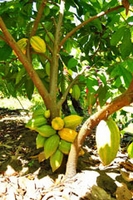 Andes Mountains of Peru.
Andes Mountains of Peru.
Visiting a banana plantation they found trees with the football-sized pods (photo by Kat Page) growing on the trunks between the taller banana trees. Out of curiosity, Pearson sent a leaf sample to the USDA near Washington, DC. He was told his beans DNA matched Pure Nacional, a bean grown in neighboring Ecuador.
“Nacional dominated the world fine chocolate market for over 100 years before it was destroyed by disease in 1916,” Pearson says.
After learning more, Pearson and partner Brian Horsley set up production in Peru to ensure quality control in the remote region. Attention is given to how the trees are pruned, the fermentation, drying and sorting.Beans are examined before and after fermentation, before and after drying and any misshapen beans are sorted out and removed.
“We have women sort out the flats and smalls (see photo). If you think of 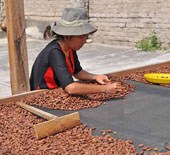 two steaks on the BBQ, one half ounce and the other 8 ounces in size, the small one will dry out if cooked the same length of time,” he said to explain how the chocolate flavor would be negatively affected. Pearson likes to provide young women, some of whom are single moms, an opportunity to work. Maranon beans are dried on an elevated table and turned frequently, several times a day.
two steaks on the BBQ, one half ounce and the other 8 ounces in size, the small one will dry out if cooked the same length of time,” he said to explain how the chocolate flavor would be negatively affected. Pearson likes to provide young women, some of whom are single moms, an opportunity to work. Maranon beans are dried on an elevated table and turned frequently, several times a day.
The chocolate we process is called Fortunato No. 4, named after the farm owner on whose farm the beans were found.
At Qzina we see the equally sized beans roast. Mellet explains the roasting sterilizes the bean to kill any fungi, develops the flavor and helps separate the shell from the inner bean. He pulled out a few to sample after 45 minutes and checked again every five or ten minutes. He opened them and Pearson was happy to spot white beans among the dark.
White beans are less bitter and therefore more desirable. Grafting is used to increase the number of white Nacional beans.
Roasting is followed by winnowing to remove the husks or shells. The outer shells are cracked and blown away to leave cocoa nibs.
Next, sugar is added to the cocoa nibs and ground. After three rounds the thick paste becomes chocolate liquor. Then the chocolate is poured into a conch to mix, aerate and further develop the flavor. This can take a few hours or days.
Almost the last step is tempering. This process raises and lowers the temperature to crystallize the cocoa butter into chocolate that is stable with a glossy snap.
Lastly, Mellet pressed the chocolate into molds. His quick practiced movements wasted no precious bit of the fine courverture.
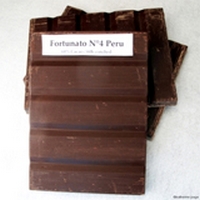 Yes, we were given samples. The chocolate is 68%, with intense chocolate taste, silky smooth with no bitterness or acidic bite. No vanilla or any flavoring is needed.
Yes, we were given samples. The chocolate is 68%, with intense chocolate taste, silky smooth with no bitterness or acidic bite. No vanilla or any flavoring is needed.
“If you had sent me diamonds and emeralds I could not be happier! I think wars could be prevented and marriages preserved with gifts such as this!” comments fan Carrie L. Chisholm scribing Fortunato No.4 on Maranon Chocolate’s blog.
Pearson explains how differently other chocolate is handled. “Most farmers rarely turn their beans. Big chocolate buys the beans based on moisture content, roasts them at very high temperatures to burn out the bad flavors from poor fermenting and drying, then add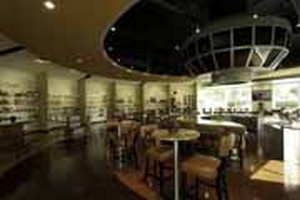 artificial flavors.”
artificial flavors.”
“Remember, to be called chocolate in the US requires only 14 to 15 percent beans,” he adds.
No one will ever confuse Maranon chocolate with an ordinary candy bar.














